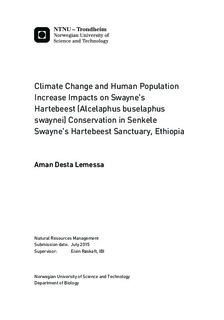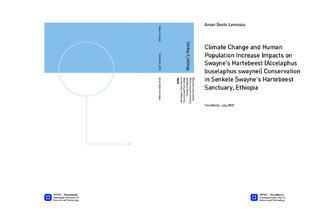| dc.description.abstract | Swayne s hartebeest (Alcelaphus buselaphus swaynei) is an endangered endemic antelope found in Ethiopia. The only viable population found in Senkele has been threatened by anthropogenic activities. Contemporary climate change together with an alarmingly increasing human population is becoming a principal conservation challenge worldwide. Therefore, assessing the extent of impacts of these contemporary factors on local protected areas is crucial to find ways to mitigate such impacts. This study evaluated the impacts of climate change and human population increase on the hartebeest conservation in Senkele Swayne s hartebeest Sanctuary. Some socioeconomic, environmental and the hartebeest behavioural components were integrated in the study. Precipitation, temperature, flight initiation experiments and questionnaires data were collected during the summer of 2014. There was a fast human population growth rate (reached more than 42% within ten years), characterized by high level of illiteracy, agriculture dominated livelihood with presence of a large cattle population. Livestock grazing remains the principal conflict source in the sanctuary, and it is more intensified by longer drought periods and absence of alternative foraging places. The hartebeests are imposed to high level of disturbance by local people. However, the absence of lethal activities, and the frequent contact between hartebeest and local people have allowed them to adapt the presence of local people. In flight distance experiments, they showed higher flight distance to strangers than to local people. Precipitation of all months showed either increasing or decreasing trends, and the annual precipitation showed an insignificant decline trend from 1984 2013. Months from December to January showed a significant decline trends with high variation. The seasonal lag and decline in precipitation amount together with an increase in temperature, affected the rain-fed dependent livelihood of local people. Moreover, such climatic variability has a potential to distress the physiology of the hartebeest. The accelerated demographic and environmental changes in the area are escalating challenges to conservation of an already endangered antelope. Fine-tuned and incentive-based approaches have been implemented to minimize human impacts, however, far from bringing the significant conservation tips. An urgent conservation measurement is needed from local and global conservation communities to ensure the survival of this antelope. | |

